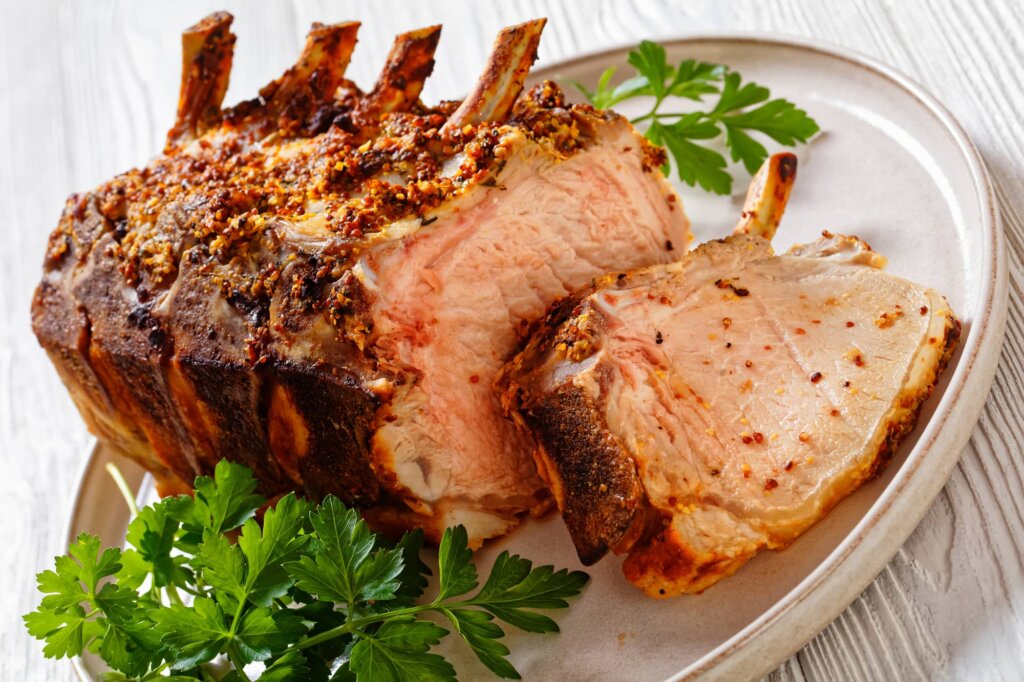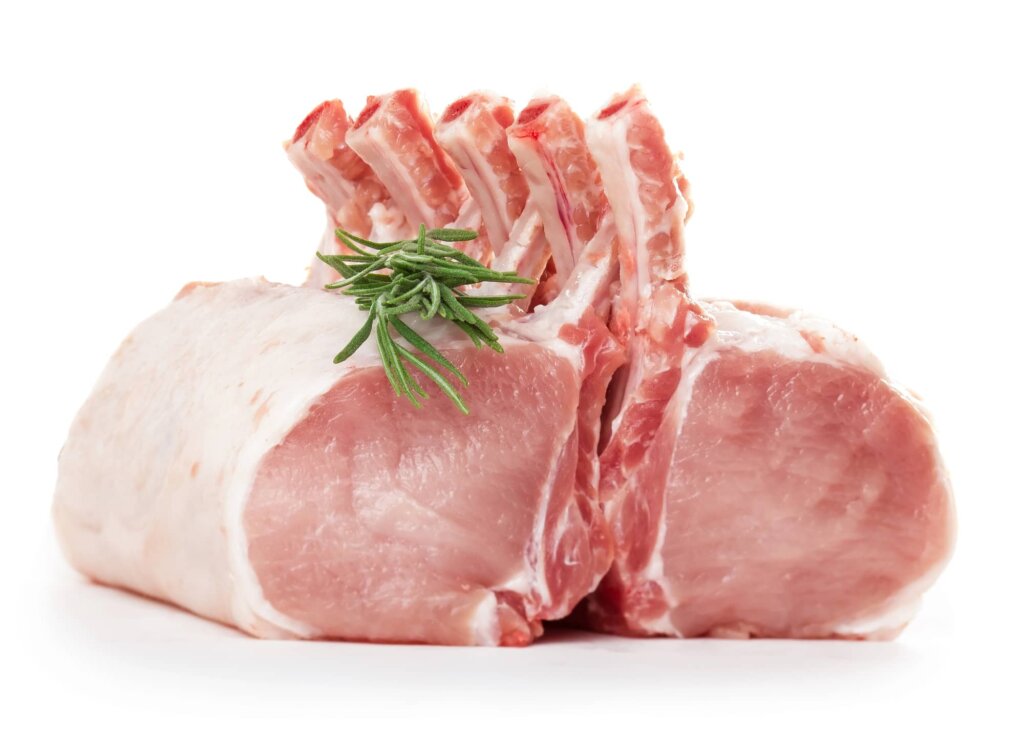
A rack of pork is an impressive, flavorful cut that’s not as challenging to prepare as you might think. You can roast it in the oven or sear it over an open flame on the grill to achieve a juicy, tender result each time. With the right seasoning and cooking techniques, it makes for a show-stopping and eye-catching star of your meal. Learn how to choose the best cut, what methods work best, what to serve with a rack of pork, and more.
What is Rack of Pork?
A rack of pork is a bone-in cut from the rib section of a pig, similar to a prime rib but with pork. It typically includes eight to ten ribs, although it sometimes has more, and is known for its rich flavor, tenderness, and impressive presentation with bones still intact. The meat is well-marbled, which helps keep it juicy when cooked properly.
Often roasted or grilled, you can serve a rack of pork whole or slice it into individual chops using the bones as a guide. A natural fat cap enhances the flavor as the meat cooks, making a rack of pork perfect for slow-cooking methods that allow the meat to stay moist while developing a beautifully caramelized crust. This cut is popular for special occasions, but it’s also simple enough to prepare for a hearty weeknight meal.
Selecting the Best Rack of Pork
When selecting a rack of pork, look for a cut with a healthy pinkish-red color and plenty of marbling. You can identify marbling by looking for thin white streaks of fat that run through the pork. The fat cap — a layer of fat on the outer edges of the rack of pork — should evenly cover the pork and be a somewhat even thickness. Try to avoid cuts that appear dry or have excessive liquid in the packaging, both of which are signs that the meat could have been stored improperly.
If possible, opt for heritage-breed or pasture-raised pork, either of which tends to have high-quality flavor and texture. If visiting a butcher, ask for a “Frenched” rack, where they clean and expose the rib bones for a more elegant look.

Tips for Success
Follow these expert tips to get the most out of your rack of pork:
- Let it come to room temperature: Take the pork out of the fridge at least 30-45 minutes before cooking to help it come to an even temperature throughout, which will allow the inside to cook evenly with the outside.
- Score the fat cap: Lightly score the fat cap in a crosshatch pattern to make seasoning and heat penetrate better.
- Season generously: Pork can handle bold flavors, so use a mix of salt, pepper, garlic, and herbs to liven it up. You can even add brown sugar for caramelization.
- Use a meat thermometer: For the best results, cook to an internal temperature of 140-145°F, and use a reliable digital thermometer for accuracy.
- Rest before carving: Let the pork rest for at least 10-15 minutes after cooking so the juices redistribute and keep the meat tender.
- Slice between the bones: Cut along the bones for perfect, evenly portioned pork chops.
Rack of Pork Recipe Variations
Once you become familiar with cooking a rack of pork, you’ll probably feel more confident in veering from a recipe to make it more your own.
For inspiration, here are a few ideas. For a classic herb-crusted roast, rub the pork with garlic, rosemary, thyme, and Dijon mustard. If you prefer sweet and savory, try a brown sugar and apple cider glaze, which caramelizes as it cooks for rich flavor. Or do a bold and smoky twist by seasoning the pork with smoked paprika, cumin, and chili powder before grilling. You can also marinate the pork overnight in liquids like balsamic vinegar or citrus juice for extra flavor.
Different Methods of Cooking Rack of Pork
The two most common methods of cooking rack of pork are in the oven and on the grill. Here’s how to successfully accomplish both.
In the Oven
Make a roasted rack of pork in the oven when you don’t want to fire up the grill. Let the pork come to room temperature for about 30-45 minutes before cooking to help it cook evenly. Preheat the oven to 450°F. Pat the rack of pork dry, then drizzle with a light layer of olive oil before seasoning generously with salt, pepper, garlic, and fresh herbs like rosemary or thyme.
Place the pork on a rack inside a roasting pan. Roast uncovered for 15-20 minutes, or until a golden brown crust starts to form. Then bump the heat down to 325°F to roast for another 1-2 hours, or about 20 minutes per pound. The final temperature should reach 140-145°F for medium. Rest the pork for 15 minutes at room temperature before slicing.
On the Grill
Grilling infuses smoky flavors into a rack of pork. Before starting, let the pork sit at room temperature for 30-45 minutes. Meanwhile, prepare the grill using a two-zone method: one side with high heat and the other side with low heat.
After resting the pork, pat it dry with paper towels. Drizzle a light layer of olive oil on all sides, and season with salt, pepper, and your other seasoning choices. Sear the pork fat-side down over direct heat for about 4-5 minutes until it begins to brown. Then, move it to the low-heat side of the grill, close the lid, and cook indirectly at 325-350°F. Let it cook for about 20 minutes per pound, or until the internal temperature reaches 140-145°F.
When finished, remove the rack of pork from the grill to rest at room temperature for 10-15 minutes.
What to Serve With Rack Of Pork?
A great rack of pork deserves equally delicious sides to round out the meal. Whether you want something hearty, fresh, or comforting, these options are excellent pairings for the rich, juicy flavors of pork.
- Roasted vegetables: Oven-roasted Brussels sprouts, carrots, or asparagus add caramelization and a little crispiness to a tender rack of pork.
- Potato sides: Creamy mashed potatoes, crispy roasted baby potatoes, or cheesy scalloped potatoes are classic sides for pork.
- Light and fresh sides: Make a crisp apple and arugula salad, tangy cabbage slaw, or smoky grilled peaches to balance the pork dish.
- Grains and breads: Add texture and variety to your plate with wild rice pilaf, honey butter cornbread, or creamy polenta.
Try It Yourself
Once you learn to cook a rack of pork at home, the results will likely be nothing short of impressive. Choose to roast it in the oven or on the grill — either way, you’ll have a tasty protein for the family to enjoy. Visit Steak University for more recipes, side dish ideas, and cooking guides.

